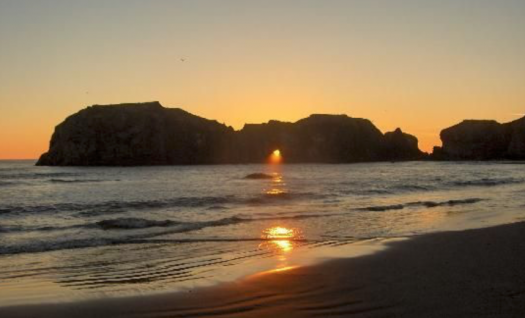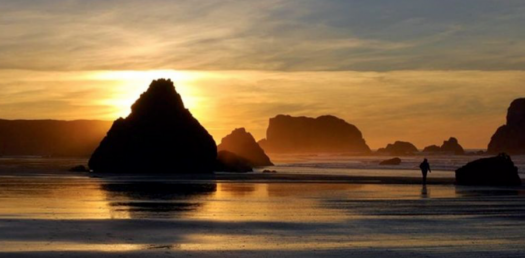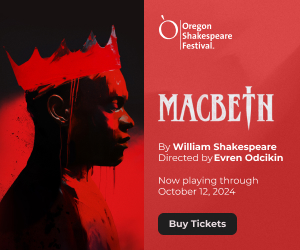

 Spring '24 Issue - Best Of Winners Announced & More
Spring '24 Issue - Best Of Winners Announced & More 
Wednesday, October 24, 2018
Bandon to Bandon
Bandon to Bandon
An indomitable, immigrant spirit and a story waiting to be told
Story and photography by Christopher Warner
In May 1873, George Bennett, an Irishman accompanied by his teenage two sons, arrived at the mouth of the Coquille River along the southwest Oregon coast. The Bennetts had recently traveled over 8,000 miles, crisscrossing the rugged, untamed frontier before reaching their destination. The elder Bennett, a graduate of Trinity College and adventurous, now set his sights on carving out a new life in America. He envisioned the vast potential of the timber-reach region and its navigable river, and soon purchased large tracts of land in the sparsely populated area known as “The Ferry.” There he would prosper, reinventing himself as “Lord” Bennett, and name the settlement after his Irish birthplace, Bandon.
I recently retraced Bennett’s journey in reverse order. Although I bravely endured hostile TSA agents and treacherously long airport lines, my path proved far less difficult. The excursion revealed uncanny similarities, as well as stark contrasts between the sister cities, and allowed me to follow some of the Bennetts’ same footsteps, imagining the thrills and hardships of the immigrant-powered, pioneer spirit.
Starting from my home in Portland, I headed south for the first leg of the trip. The drive provided ocean vistas and abundant woodlands. I reached Coos County around dinnertime and turned onto Beach Loop Drive to watch the sun slowly dip into the ocean. I was surprised by the somewhat diminutive size of the Coquille Lighthouse that sits on the edge of Bullards Beach, and awestruck by another of Bandon’s prominent landmarks, the striking rock formations found just offshore, with Face Rock as its centerpiece attraction.
According to legend, the uplifted, stone face belongs to Ewanua, a beautiful Indian princess of the Nah-So-Mah tribe and the daughter of Chief Siskiyou. Following a feast celebration, Ewanua carried her dog, Komax, her cat and a basket full of kittens down to the beach for a late night swim in the ocean. Unaware of any dangers, she was suddenly attacked by Seatka, a feared evil spirit lurking undersea. The monster tried to get her to look at him, but she refused, knowing his eyes wielded all his power. So the fair princess forever lies here in repose, shunning Seatka and gazing skyward, while her dog, cat and kittens wait nearby.
I bid Ewanua goodnight and strolled the ten-block section of Old Town with its offering of shops, art galleries and restaurants. With a population of about 3,000 people, the sleepy hamlet is best known for its welcoming beaches, and cranberry farms that produce a staggering 30 million pounds annually and 95% of the state’s ruby-colored fruit. Since 1947, the town has celebrated harvest with a Cranberry Festival in September, featuring a parade, live music, fresh seafood, a street dance, and lots of cranberry-infused concoctions.
Another prominent hue, the bright yellow blossoms of Ilux Europaeus, gorse, dot the landscape. Introduced by Bennett in an attempt to combat sea erosion, the thorny, evergreen shrubs later resulted in tragic consequences. Gorse flowers emit a pleasant, almond-like fragrance. They also contain a highly flammable, oily residue, which played a major role in a devastating fire that destroyed the entire town in 1936. Undaunted, locals gradually rebuilt their seaside hometown brick-by-brick, though always trying to control and eradicate the thorny nuisance.
The next morning, following a good night’s rest in my rental Airstream and having been serenaded to sleep by a symphony of river frogs, I visited the Bandon Historical Society. The small, well-curated museum hosts a treasure trove of old photographs, tools and artifacts preserving this chapter of the Pacific Northwest’s history. Before leaving, I paid my final respects to Lord Bennett, whose gravesite rests on a bluff overlooking the ocean in Holy Trinity Catholic Cemetery, where fittingly, he still commands attention.
As I prepared to leave the country, I received an email from Oregon historian, Jim. Proehl. He had forwarded a letter from Bennett’s great-great-granddaughter, Meredith Jewett, who conducted extensive research about her relative. She believed the title “Lord” had been more of a pet name given to him by the hardscrabble lumberjacks and fur trappers, who undoubtedly would have viewed the genteel, highly-educated Bennett in a more noble light.
The second leg of my journey started with a long airplane flight, a far cry different from an ocean crossing by boat. After landing at Dublin Airport and renting a car, I set out for County Cork in southwest Ireland, a place Bennett, as well as scores of other emigrants (including ancestors of my own), once called home. I made my way along a meandering, diagonal route, leisurely slicing through the Emerald Isle and its ubiquitous green hills and sheep-marked pastures. I marveled at the scenic wonders on the fabled Ring of Kerry while navigating narrow roads during frequent rain showers. Welcome to Ireland.
While Bandon Oregonians tend to look upon gorse with contempt, the opposite is true in Ireland. Also known as furze, broom, and whin, a sea of yellow pedals figures prominently throughout the country and is used for fuel, animal fodder, dyes, fencing, and even as a cure for scarlet fever. The plant is linked to Ireland’s history and mythology. The pagan association held that gorse harbored witches within its spiky domain. On May Day, gorse would be set alight in the hope of flushing out any witches hiding there, who would then transform themselves into the shape of hares and thus evade the flames by leaping swiftly to safety.
In no hurry to end my road trip, I eventually arrived at the ancient, walled town straddling the River Bandon. Founded in the early 1600s by English settlers as part of the Munster Plantation, Bandon began as two distinct settlements on opposite sides of the river. The Irish name Droichead na Bandanmeans Bridge of Bandon and is still referred to as the gateway to West Cork and located ten miles inland from the Celtic Sea. In 1618, the powerful Earl of Cork, Richard Boyle, helped finance the development of the region and consolidated the towns by constructing thick walls stretching a mile wide. A century later, the lands became the property of the Dukes of Devonshire, who enhanced Bandon with elegant buildings, markets and a sophisticated system of wells.
Like many European countries, the area saw its share of bloody feudal conflicts, conquests and civil wars. By the mid-19th century, Bandon had emerged as a leading industrial center, especially in the production of alcohol. At its peak, the town was home to five breweries, two distilleries, and included an annual production of over 600,000 gallons of whiskey by the now-shuttered Allman’s Distillery. The industrial revolution, as well as the rapid growth of Cork City (Ireland’s second largest city), would eventually relegate Bandon’s standing and drastically affect its growth and economy.
Today, with a population of nearly 7,000 residents, Bandon moves at a slower pace, but remains a vibrant destination for tourists and history enthusiasts keen on discovering the town’s colorful past. Additionally, the annual Bandon Music Festival is held in early June, and a Walled Town Festival takes place every year on the last weekend of August.
From the vantage point on Kilbrogan Hill above the north riverbank, I glimpsed many of Bandon’s well-known landmarks, including the original town walls, two Gothic Revival Catholic churches, and the Protestant Christ Church that now serves as the West Cork Heritage Center. Built in 1610, the former house of worship features an old classroom, a traditional village pub, medieval stocks and several displays chronicling 400 years of activity.
John Hurley, the Heritage Center’s secretary gave me a private tour, graciously providing a fascinating crash course on all things Bandon. Regarding the questionable title of Lord Bennett, he confirmed there had been local Bennetts with ties to Irish gentry, but any designation would have been inherited and most likely long extinct by the time of George Bennett’s departure.
My subsequent return to Oregon was met with the dreaded jet lag, stacks of unopened mail and scornful looks from my cats saying, “Where have you been?!” But as soon as I caught up on sleep and resumed my routines, I began to plot other similarly-themed Beaver State adventures. Dundee to Dundee? Or how about Florence to Florence? Surely there must be a Gianni Bennettoni or Angus Bennettson with an indomitable, immigrant spirit and a story waiting to be told. Stay tuned.
Events & Promotions
Apr
29
May
03
Gold Hill
Del Rio Vineyard Dinner in the Vineyard Spring edition OREGON FEAST
Let's celebrate Oregon Wine Month. Join us for an evening of wine ...
Jun
16
Grants Pass | Ends Jul 04, 2024
Racing on the Rogue is back in 2024 at Oregon’s premier racetrack, Grants Pass Downs!
Racing on the Rogue is back in 2024 at Oregon’s premier racetrack, ...
Jun
29
Gold Hill
Del Rio Vineyards Dinner Under the Stars
Let us dazzle you with an evening under the stars in our picturesque ...
Sep
21
2310 Voorhies Rd
Oregon Honey and Mead Festival
Oregon Honey and Mead Festival Honey, Music, Art, Native ...















